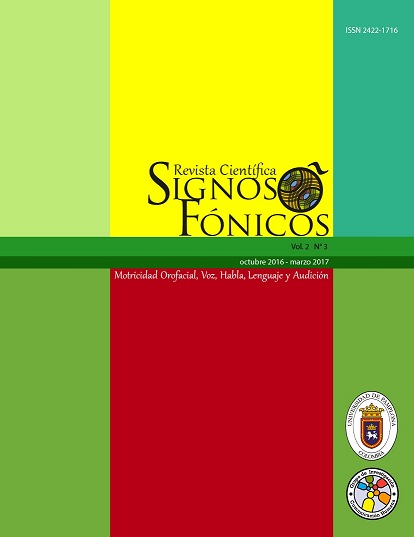Analisis de formantes vocalicos normalizados y no- normalizados para el Español Colombiano
DOI:
https://doi.org/10.24054/rcsf.v2i3.2125Palabras clave:
Habla, Acústica, DiagnosticoResumen
INTRODUCCIÓN: Definir valores de referencia para diagnóstico del habla a través de los formantes vocálicos normalizados y no normalizados del español colombiano. MÉTODOS: Estudio transversal con inclusión población aleatoria por muestreo estratificado. 111 participantes 45 hombres, 66 mujeres.Recolección de datos con frase vehicular para vocales sostenidas. Analisis No Normalizado usando mediana y media por genero y edad. Análisis Normalizado a través de Labov y Nearey. RESULTADOS: Los valores de referencia encontrados son: (1) No-Normalizados: /a/ F1 867,03 Hz, F2 1435,85 Hz, /e/ F1 482,69 Hz, F2 2152,30 HZ; /i/ F1 330,48 Hz, F2 2400,11 Hz; /o/; F1 488,62 Hz, F2 984,22Hz; /u/ F1 368,93 Hz, F2 815,88 Hz; (2) Normalizción Labov: /a/ F1 1106,8 Hz, F2 1831,1 Hz, /e/ F1 616,5 Hz, F2 2755,4 Hz; /i/ F1 422 Hz, F2 3072 Hz; /o/; F1 623,7 Hz, F2 1255,8 Hz; /u/ F1 471 Hz, F2 1047,7 Hz; (3) Normalización Nearey /a/ F1 846 Hz, F2 1347 Hz, /e/ F1 467 Hz, F2 1954 Hz; /i/ F1 312 Hz, F2 2190 Hz; /o/; F1 463 Hz, F2 940 Hz; /u/ F1 350 Hz, F2 759 Hz. ANÁLISIS Y DISCUSIÓN: El método de normalización que da cuenta de la conformación acústica y articulatoria del español colombiano es el de Nearey con inclusión del tercer formante para el cálculo del centroide S. CONCLUSIONES: La inclusión del tercer formante durante la normalización de Nearey permite ajustar los valores del Espacio Vocálico a la configuración acústica y articulatoria del español.
Descargas
Referencias
Darley A, Aronson A, Bronw J. Differential Diagnostic Patterns of Dysarthria. Journal of Speech, Language, and Hearing Research. 1969 Oct 246-269.; 12.
Darley A, Aronson A, JR B. Clusters of Deviant Speech Dimensions in the Dysarthrias. Journal of Speech, Language, and Hearing Research. 1969 Sept; 12: p. 462-496.
Longemann J, Fisher H, Boshes B, Blonsky E. Frequency and Cooccurrence of Vocal Tract Dysfunctions in the Speech of a Large Sample of Parkinson Patients. Journal of Speech and Hearing Disorders. 1978 Feb; 43: p. 47-57.
Murdoch B, Vitorio J. Disartria: Uma abordagem fisiológica para avaliação e tratamento São Paulo: Lovise; 2005.
Kent R, Weismer G, Kent J, Vorperian H, Duffy J. Acoustic Studies of Dysarthric Speech: methods, progress, and potential. Journal of Communication Disorders. 1999 May-Jun; 32(3): p. 141-186.
Ackermann H, Ziegler W. Articulatory deficits in parkinsonian dysarthria: an acoustic analysis. Journal of Neurology, Neurosurgery & Psychiatry. 1991; 58: p. 1093-1098.
Kent R, Kim Y. Toward an acoustic typology of motor speech disorders. Clinical linguistics & phonetics. 2003 Sep; 17(6): p. 427-445.
Cohen A, Renshaw T, Mitchell K, Kim Y. A psychometric investigation of “macroscopic” speech measures for clinical and psychological science. Behavior Research Methods. 2016 June; 48(2): p. 475-486.
Bunton K, Weismer G. The Relationship Between Perception and Acoustics for a High-Low Vowel Contrast Produced by Speakers With Dysarthria. Journal of Speech, Language, and Hearing Research. 2001 Dec; 44: p. 1215-1228.
Van Lancker Sidtis D, Pachana N, Cummins J, Sidtis J. Dysprosodic speech following basal ganglia insult: Toward a conceptual framework for the study of the cerebral representation of prosody. Brain and Language. 2006 May; 97(2): p. 135-153.
Tsanas A, Little M, McSharry P, Spielman J. Novel Speech Signal Processing Algorithms for High-Accuracy Classification of Parkinson’s Disease. IEEE Transactions on Biomedical Engineering. 2012 Jan; 59(5): p. 1264 - 1271.
Sapienza C, Statholoupolus E. Speech task effects on acoustic and aerodynamic measures of women with vocal nodules. Journal of voice. 1995 Dec; 9(4): p. 413-418.
Rusz J, Cmejla R, Tykalova T. Imprecise vowel articulation as a potential early marker of Parkinson’s disease: Effect of speaking task. Journal of Acoustical Society of America. 2013 Sep; 134(3): p. 2171-2181.
Bunton K, Kent R, Kent J, Rosenbek J. Perceptuo-acoustic assessment of prosodic impairment in dysarthria. Clinical Linguistics & Phonetics. 2000; 14(1): p. 13-24.
Polka L, Bohn O. Natural Referent Vowel (NRV) framework: An emerging view of early phonetic development. Journal of Phonetics. 2011 Oct; 39(4): p. 467-478.
Hillenbrand J, Clark M, Houde R. Some effects of duration on vowel recognition. Journal of Acoustical Society of America Meeting. 2000 Dec; 108(6): p. 3013-3022.
Flynn N. Comparing Vowel Formant Normalisation Procedures. York Papers in Linguistics. 2011 March; NA(11).
Vitela A, Warner N, Lotto A. Perceptual compensation for differences in speaking style. Front Psychol. 2013 Jul; 4.
Sandoval S. Automatic assessment of vowel space area. Journal of Acoustical Society of America. 2013 Nov; 13(4): p. EL477-EL483.
Tyler K, Thomas E. R package, versión 1.2-1. [Online]. Oregon; 2015 [cited 2016 May 15. Available from:http://blogs.uoregon.edu/vowels/.
Disner, Sandra Ferrari. 1980. Evaluation of vowel normalization procedures. Journal of the Acoustical Society of America 67:253-61. [ Online: JASA
dank, Patti, Smits, Roel, and van Hout, Roeland. 2004. A comparison of vowel normalization procedures for language variation research. Journal of the Acoustical Society of America 116:3099-107. [Online: JASA ]
Descargas
Publicado
Número
Sección
Licencia
Derechos de autor 2016 Heriberto Rangel Navia, Daniela Andrea Chinchilla Rodriguez, Jennifer Lisbeth Espinosa Calderon

Esta obra está bajo una licencia internacional Creative Commons Atribución-NoComercial-SinDerivadas 4.0.











